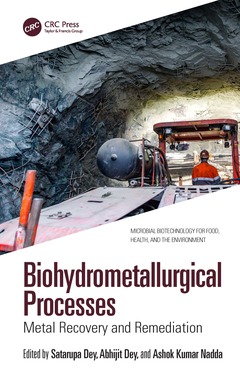Description
Biohydrometallurgical Processes
Metal Recovery and Remediation
Microbial Biotechnology for Food, Health, and the Environment Series
Coordinator: Dey Satarupa
Language: English
Subjects for Biohydrometallurgical Processes:
Keywords
Beneficiation; bioleaching; bioreactors; rare earth elements; Acid Mine Drainage; Metagenomics; Copper; Zinc; Cobalt; Nickel
· 15.6x23.4 cm · Hardback
Description
/li>Contents
/li>Readership
/li>Biography
/li>
Extensive industrialization has led to an increased release of toxic metals into the soil and air. Industrial waste can include mine overburden, bauxite residue, and E waste, and these can serve as a source of valuable recoverable metals. There are relatively simple methods to recycle these wastes, but they require additional chemicals, are expensive, and generate secondary waste that causes environmental pollution. Biohydrometallurgical processing is a cost-effective and ecofriendly alternative where biological processes help conserve dwindling ore resources and extract metals in a nonpolluting way. Microbes can be used in metal extraction from primary ores, waste minerals, and industrial and mining wastes. Biohydrometallurgical Processes: Metal Recovery and Remediation serves as a useful guide for microbiologists, biotechnologists, and various industrialists dealing with mining, metallurgy, chemical engineering, and environmental sciences.
Features:
- Examines advances in biohydrometallurgy, biomineralization, and bioleaching techniques
- Discusses the importance of bacteria in biohydrometallurgical processes and microbial interventions for waste cleanup and upgradation of minerals
- Presents the latest techniques for biosynthesis related to different metals, along with recent developments in alternative procedures using extremophiles and leaching bacteria
1. Formation Mechanisms and Prevention Strategies of Microorganism-Influenced Corrosion Biofilms. 2. Impacts of Biofouling on Marine Environments and Its Prevention. 3. Metagenomic Analysis of Acid Mine Drainage, Presence of Acidometallophiles and Their Possible Role in Biomining. 4. Environmental Rehabilitation of Industrial Waste Dumping Site. 5. Metagenomics-Based Characterization of Microbial Diversity across Industrial Waste Dumping Sites. 6. Application of Microbes in Leaching Rare Earth Elements and Radioactive Elements: Bioleaching of Rare Earth Elements: A Challenge and Success. 7. An Understanding of the Underlying Mechanisms Involved in the Bacterial Remediation of Arsenic, Cadmium, and Lead. 8. Mechanism of Long-Term Arsenic Remediation by Microbial Intervention. 9. Metagenomics for Studying Bioleaching Bioreactor. 10. Bioleaching: A Method of Microbial Recovery of Metal Values from Industrial Wastes. 11. Treasure Hunt: Converting E-Waste to E-Wealth. 12. Role of Sulfate-Reducing Bacteria in Sustainable Acid Mine Bioremediation. 13. Algae as a Bioremediation of Heavy Metal-Associated Water Pollution.
Dr. Satarupa Dey is an Assistant Professor in the Department of Botany at Shyampur Siddheswari Mahavidyalaya, affiliated to the University of Calcutta, West Bengal, India. She earned her BSc in Botany from the University of Calcutta, West Bengal, India. She holds also an MSc in Botany with Microbiology specialization from the same university. She completed her PhD in 2012, and her field of expertise is Bioremediation of Toxic Metals. She was selected as a Department of Biotechnology, Government of India research fellow and later worked as a visiting scientist in the Agricultural and Ecological Research Unit of the Indian Statistical Institute, Kolkata. She is the recipient of the Woman Scientist (WOS A) fellowship of the Department of Science and Technology, Government of India. She has published research and review articles in several journals of national and international repute. She has co-edited three books and is an active reviewer for many high-impact journals published by Elsevier, Springer Nature, and Nature Publishers.




